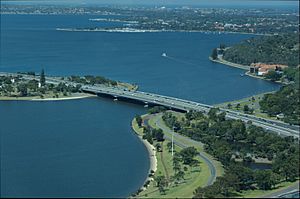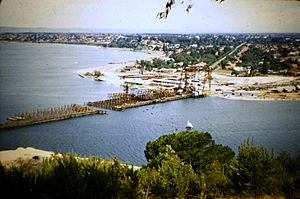Narrows Bridge (Perth) facts for kids
Quick facts for kids Narrows Bridge |
|
|---|---|
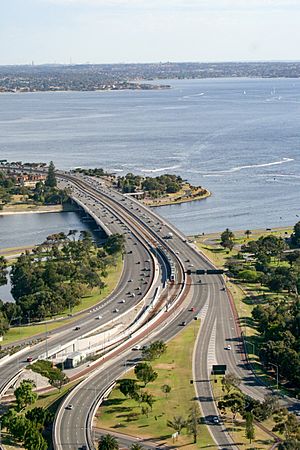
The Narrows Bridge viewed from QV1, showing the two road bridges and railway bridge
|
|
| Type | State Registered Place |
| Designated | 23 April 1999 |
| Reference no. | 4795 |
The Narrows Bridge is a set of bridges that cross the Swan River in Perth, Western Australia. It carries both a freeway and a railway line.
These bridges are built at a narrow part of the river, connecting the Mitchell and Kwinana freeways. This link is super important for connecting the northern and southern parts of Perth. The very first road bridge opened in 1959. It was special because it was the biggest bridge in the world at the time made from a new type of concrete called "precast prestressed concrete."
Building the bridge meant creating new land from the river. This made space for the bridge and its connecting roads. The Narrows Bridge was part of the Kwinana Freeway, which was quite short back then. As Perth grew, more and more cars used the bridge. So, in 2001, a second road bridge was built. A few years later, in 2005, a railway bridge was added between the two road bridges. Trains started using it in 2007 when the Mandurah railway line opened.
Contents
The First Road Bridge: 1959
| Narrows Bridge Southbound |
|
|---|---|
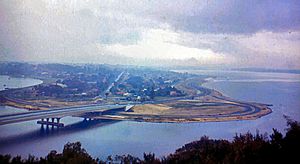
The bridge viewed from Kings Park, c. 1959
|
|
| Coordinates | Lua error in Module:Coordinates at line 614: attempt to index field 'wikibase' (a nil value). |
| Carries | Kwinana Freeway (southbound road lanes) |
| Crosses | Swan River |
| Maintained by | Main Roads Western Australia |
| Heritage status | WA Heritage Register |
| Next upstream | Boorloo Bridge |
| Next downstream | Stirling Bridge |
| Characteristics | |
| Material | Reinforced concrete |
| Total length | 396.5 m (1,301 ft) |
| Width | 27.4 m (90 ft) |
| Longest span | 98 m (322 ft) |
| Number of spans | 5 |
| Piers in water | 2 |
| History | |
| Designer | Sir William Holford |
| Construction begin | 8 June 1957 |
| Opened | 13 November 1959 |
People thought about building a bridge at this spot as early as 1849. The narrow river section seemed perfect. In 1899, a bridge was suggested, but it was too expensive. Serious planning for a bridge finally started in 1947.
However, this planning was paused to build new bridges for The Causeway first. After the new Causeway bridges opened in 1952, traffic quickly doubled. This made everyone realize a bridge at the Narrows was urgently needed.
How the Bridge Site Was Chosen
Work to check the bridge site began in August 1954. The Town Planning Commission suggested the Narrows location. Some people worried the bridge would block the beautiful views of the city. Also, people living nearby were upset about a big highway next to their homes.
The chosen site also needed a lot of land to be created from Mounts Bay. This land reclamation started in October 1954. Workers added huge amounts of sand, much of it dug from Melville Water.
Building the First Bridge
The state government started saving money for the new bridge in September 1954. The construction was approved in November 1954. This shows how important a new traffic link was for Perth.
The riverbed was very soft, with mud going down 80 feet. An engineer, Ernie Godfrey, traveled to study bridges built in similar places. A British company, Maunsell & Co., won the job to design the bridge.
Construction of the roads began in 1956. The contract for the bridge itself was signed in March 1957. A Danish company, Christiani & Nielsen, worked with a Western Australian company, J. O. Clough & Son, to build it.
The first temporary wooden pole for construction was put in on June 8, 1957. The first permanent pole for the bridge went in on August 18, 1957. Workers started making the concrete beams in September 1957. The last concrete beam was put into place in June 1959.
Naming and Opening the Bridge
In February 1959, the Deputy Premier, John Tonkin, announced the bridge would be called the Golden West Bridge. But "Golden West" was also a popular soft drink! People made fun of the name, so it was quietly changed.
The bridge cost about £1.5 million, which was a lot of money back then. The whole road system cost £3.5 million. Building the bridge took two years and five months.
The Governor, Charles Gairdner, officially opened the bridge on November 13, 1959. He was also the first person to drive across it. The new bridge was part of the Kwinana Freeway, which was considered the "most modern highway" in Western Australia.
Bridge Design Features
The bridge was designed by G. Maunsell & Partners and William Halford & Partners. They used a new method called prestressed concrete. This was different from the usual wooden bridges in Western Australia. The bridge has a gentle arch shape.
Because the soil was so soft, they used special "Gambia piles" for the foundations. These piles have steel shells and were filled with reinforced concrete. They support the bridge's main parts.
The bridge has five sections, called spans. The middle span is the longest, at 320 feet. There are also footpaths on both sides, 8 feet wide. These paths are separated from the road by light aluminum fences. Street lights were built into these fences.
Workers made the concrete parts of the bridge on the southern river shore. Then, they lifted them into place using temporary wooden structures. These parts were joined together with strong wires and stretched tight. The new bridge could handle 6,000 cars per hour in each direction, with six traffic lanes.
What Happened After It Opened
In 1996, the bridge was strengthened. Also, pretty night lights were added to both sides. The bridge was added to the state's heritage list in 1999. It was also named an important engineering landmark.
The bridge made it easier to get to Perth's city center from the south. This caused many more people to move south of the river. More people meant more cars, leading to huge traffic jams during busy times.
By the 1990s, the Narrows Bridge was the worst traffic spot in the city. Even with an extra lane, making seven lanes in total, it was still very crowded.
The Second Road Bridge: 2001
| Narrows Bridge Northbound |
|
|---|---|
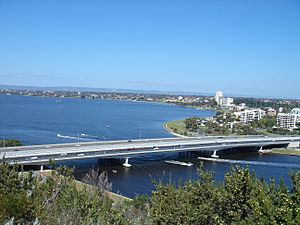
The duplicate bridge seen here in the foreground, with the darker road surface.
|
|
| Carries | Kwinana Freeway (northbound road lanes); Northbound railway line |
| Crosses | Swan River |
| Maintained by | Main Roads Western Australia |
Talk about a second Narrows Bridge started in the 1970s, but nothing happened. By 1998, the original bridge carried 155,000 vehicles every day. It was the busiest part of any freeway in Australia. This was far more traffic than the bridge was designed for.
Road planners first thought about making the existing bridge wider. They planned to build a smaller second bridge next to it and join them. This would add more traffic lanes.
Why a New Bridge Was Built
In April 1998, the state government announced a plan to widen the Narrows Bridge. This plan would add four extra traffic lanes. However, the Minister for Transport, Eric Charlton, later approved building a completely separate second road bridge. This new plan would save money and cause less disruption to traffic on the old bridge.
Building a separate bridge was also important because new foundations might settle differently in the soft riverbed. The new bridge would run next to the original, with a 6-meter gap. It was designed to look very similar to the first bridge.
How the Second Bridge Was Built
Leighton Contractors won the contract to build the new bridge. They used a method called "incremental launching." This meant they made 28-meter long sections of the bridge on both shores. Then, they pushed these sections out into place over the river.
As the bridge was being launched, it rested on temporary poles. Once the whole structure was in place, these temporary poles were removed. The bridge then rested on its permanent supports. This construction needed about 250 steel poles.
The construction faced some delays, including worker strikes and an algal bloom in the river. The second bridge finally opened to traffic on February 26, 2001. It was officially opened on May 30, 2001. This new bridge had six lanes, including one for buses. The original bridge was also changed to have six traffic lanes.
The Railway Bridge: 2005
| Narrows Rail Bridge | |
|---|---|
| Carries | Southbound railway line |
| Crosses | Swan River |
| Characteristics | |
| Number of spans | 5 |
| Piers in water | 2 |
| History | |
| Opened | 23 December 2007 |
While the second road bridge was being built, the idea of a railway line to Mandurah became a big topic. The government at the time wanted to build a railway that only partly followed the freeway. However, the opposition party wanted the railway to cross the Narrows Bridge and run along most of the freeway.
When the Labor party won the state election in 2001, they decided to build the railway across the Narrows Bridge. A third bridge was needed because there wasn't enough space planned when the second bridge was built.
Building the Rail Bridge
Leighton Constructions also won the contract to build the railway part of the freeway. They built a narrow southbound railway bridge in the 6-meter gap between the two existing road bridges. The eastern side of the northbound (2001) bridge was also made stronger to hold the northbound railway track.
Construction was planned to start in July 2005 and finish by December 2005. The first passengers rode trains across the Narrows on December 23, 2007, when the Mandurah line officially opened.
The railway bridge deck was made from nine huge steel beams. Each beam weighed almost 100 tons and was up to 54 meters long. These beams were built in Kwinana, brought to the site by road, and carefully lowered into place with a crane.
Images for kids


